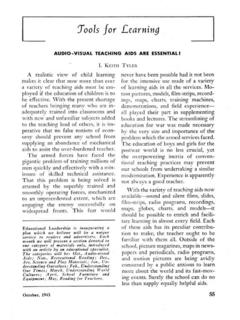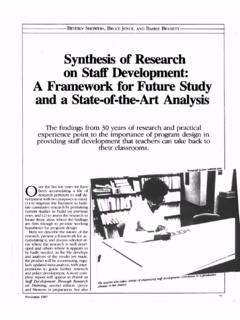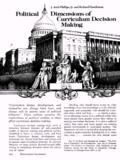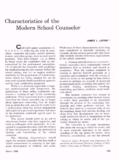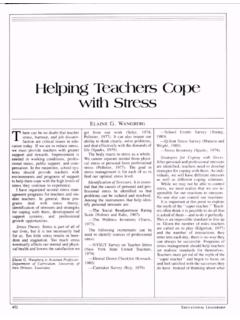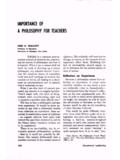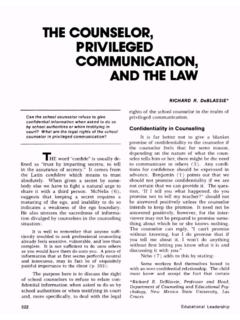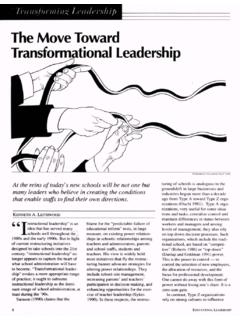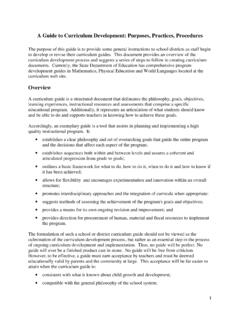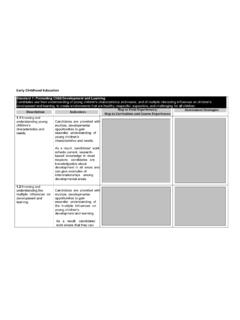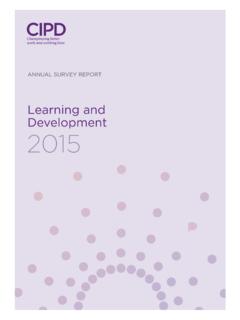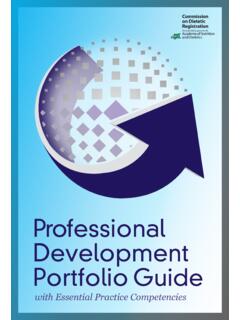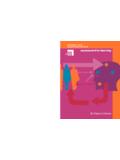Transcription of UNDERSTANDING BY DESIGN FRAMEWORK BY JAY …
1 UNDERSTANDING BY DESIGN FRAMEWORKBY JAY MCTIGHE AND GRANT : WHAT IS UbD FRAMEWORK ?The UNDERSTANDING by DESIGN FRAMEWORK (UbD FRAMEWORK ) offers a plan-ning process and structure to guide curriculum, assessment, and instruction. Its two key ideas are contained in the title: 1) focus on teaching and assessing for UNDERSTANDING and learning transfer, and 2) DESIGN curriculum backward from those UbD FRAMEWORK is based on seven key tenets:1. learning is enhanced when teachers think purposefully about curricular plan-ning. The UbD FRAMEWORK helps this process without offering a rigid process or prescriptive recipe. 2. The UbD FRAMEWORK helps focus curriculum and teaching on the develop-ment and deepening of student UNDERSTANDING and transfer of learning ( , the ability to effectively use content knowledge and skill). 3. UNDERSTANDING is revealed when students autonomously make sense of and transfer their learning through authentic performance.
2 Six facets of under-standing the capacity to explain, interpret, apply, shift perspective, empa-thize, and self-assess can serve as indicators of UNDERSTANDING . 4. Effective curriculum is planned backward from long-term, desired results through a three-stage DESIGN process (Desired Results, Evidence, and learning Plan). This process helps avoid the common problems of treating the textbook as the curriculum rather than a resource, and activity-oriented teaching in which no clear priorities and purposes are apparent. 5. Teachers are coaches of UNDERSTANDING , not mere purveyors of content knowl-edge, skill, or activity. They focus on ensuring that learning happens, not just teaching (and assuming that what was taught was learned); they always aim and check for successful meaning making and transfer by the North Beauregard StreetAlexandria, VA 22311-1714 USA1-703-578-9600 or 1-800-933-2723 2012 ASCD.
3 All Rights 21703 North Beauregard Street | Alexandria, VA 22311 1714 USA | 1-703-578-9600 or 1-800-933-2723 | Regularly reviewing units and curriculum against DESIGN standards enhances curricu-lar quality and effectiveness, and provides engaging and professional discussions. 7. The UbD FRAMEWORK reflects a continual improvement approach to student achieve-ment and teacher craft. The results of our designs student performance inform needed adjustments in curriculum as well as instruction so that student learning is UNDERSTANDING by DESIGN FRAMEWORK is guided by the confluence of evidence from two streams theoretical research in cognitive psychology, and results of student achievement studies. A summary of the key research that undergirds UbD FRAMEWORK can be found at under Research A 1 Identify Desired Results Key Questions: What should students know, understand, and be able to do?
4 What is the ultimate transfer we seek as a result of this unit? What enduring under-standings are desired? What essential questions will be explored in-depth and provide focus to all learning ? In the first stage of backward DESIGN , we consider our goals, examine established content standards (national, state, prov-ince, and district), and review curriculum expectations. Because there is typically more content than can reasonably be addressed within the available time, teachers are obliged to make choices. This first stage in the DESIGN process calls for clarity about priorities. learning priorities are established by long-term performance goals what it is we want students, in the end, to be able to do with what they have learned. The bottom-line goal of education is transfer. The point of school is not to simply excel in each class, but to be able to use one s learning in other settings.
5 Accordingly, The Three Stages of Backward DesignThe UbD FRAMEWORK offers a three-stage backward DESIGN process for curriculum planning, and includes a template and set of DESIGN tools that embody the process. A key concept in UbD FRAMEWORK is align-ment ( , all three stages must clearly align not only to standards, but also to one another). In other words, the Stage 1 con-tent and UNDERSTANDING must be what is assessed in Stage 2 and taught in Stage 3. 1703 North Beauregard Street | Alexandria, VA 22311 1714 USA | 1-703-578-9600 or 1-800-933-2723 | 3 Stage 1 focuses on transfer of learning . Essential companion questions are used to engage learners in thoughtful meaning making to help them develop and deepen their UNDERSTANDING of important ideas and processes that support such transfer. Figure 1 contains sample transfer goals and Figure 2 shows sample understandings and essential questions.
6 FIGURE 1 SAMPLE TRANSFER GOALSD iscipline/Subject/SkillTransfer GoalsMathematics Apply mathematical knowledge, skill, and rea-soning to solve real-world Effectively write for various audiences to explain (narrative, expository), entertain (creative), per-suade (persuasive), and help others perform a task (technical).History Apply lessons of the past (historical patterns) to current and future events and issues. Critically appraise historical Create and perform an original work in a selected medium to express ideas or evoke mood and 31703 North Beauregard Street | Alexandria, VA 22311 1714 USA | 1-703-578-9600 or 1-800-933-2723 | 4 FIGURE 2 SAMPLE UNDERSTANDINGS AND ESSENTIAL QUESTIONSU nderstandingsEssential QuestionsGreat literature explores univer-sal themes of human existence and can reveal truths through can stories from other places and times relate to our current lives?
7 Quantitative data can be collected, organized, and displayed in a variety of ideas can be rep-resented numerically, graphi-cally, or s the best way of showing (or repre-senting) _____? In what other way(s) can this be represented? The geography, climate, and natural resources of a region influence the culture, economy, and lifestyle of its does where we live influence how we live?The relationship between the arts and culture is mutually dependent; culture affects the arts, and the arts reflect and preserve culture. In what ways do the arts reflect as well as shape culture?Important knowledge and skill objectives, targeted by established standards, are also identified in Stage 1. An important point in the UbD FRAMEWORK is to recognize that factual knowledge and skills are not taught for their own sake, but as a means to larger ends. Acquisition of content is a means, in the service of meaning making and transfer.
8 Ultimately, teaching should equip learners to be able to use or transfer their learning ( , meaningful performance with content). This is the result we always want to keep in 4 Page 5 Stage 2 Determine Assessment Evidence Key Questions: How will we know if stu-dents have achieved the desired results? What will we accept as evidence of stu-dent UNDERSTANDING and their ability to use (transfer) their learning in new situations? How will we evaluate student performance in fair and consistent ways?Backward DESIGN encourages teachers and curriculum planners to first think like assessors before designing specific units and lessons. The assessment evidence we need reflects the desired results identified in Stage 1. Thus, we consider in advance the assessment evidence needed to document and validate that the targeted learning has been achieved. Doing so invariably sharpens and focuses teaching.
9 In Stage 2, we distinguish between two broad types of assessment performance tasks and other evidence. The perfor-mance tasks ask students to apply their learning to a new and authentic situation as means of assessing their understand-ing and ability to transfer their learning . In the UbD FRAMEWORK , we have identified six facets of UNDERSTANDING for assessment purposes. When someone truly under-stands, they Can explain concepts, principles, and processes by putting it their own words, teaching it to others, justifying their answers, and showing their reasoning. Can interpret by making sense of data, text, and experience through images, analogies, stories, and models. Can apply by effectively using and adapting what they know in new and complex contexts. Demonstrate perspective by seeing the big picture and recognizing differ-ent points of view. Display empathy by perceiving sensitively and walking in someone else s shoes.
10 Have self-knowledge by showing meta-cognitive awareness, using productive habits of mind, and reflect-ing on the meaning of the learning and the following two points in mind when assessing UNDERSTANDING through the facets:1. All six facets of UNDERSTANDING need not be used all of the time in assess-ment. In mathematics, application, interpretation, and explanation are the most natural, whereas in social studies, empathy and perspective may be added when Performance tasks based on one or more facets are not intended for use in daily lessons. Rather, these tasks should be seen as culminating performances for a unit of study. Daily lessons develop the related knowledge and skills needed for the UNDERSTANDING performances, just as practices in athletics prepare teams for the upcoming game. Page 51703 North Beauregard Street | Alexandria, VA 22311 1714 USA | 1-703-578-9600 or 1-800-933-2723 | North Beauregard Street | Alexandria, VA 22311 1714 USA | 1-703-578-9600 or 1-800-933-2723 | 6In addition to performance tasks, Stage 2 includes other evidence, such as tradi-tional quizzes, tests, observations, and work samples to round out the assess-ment picture to determine what students know and can do.
